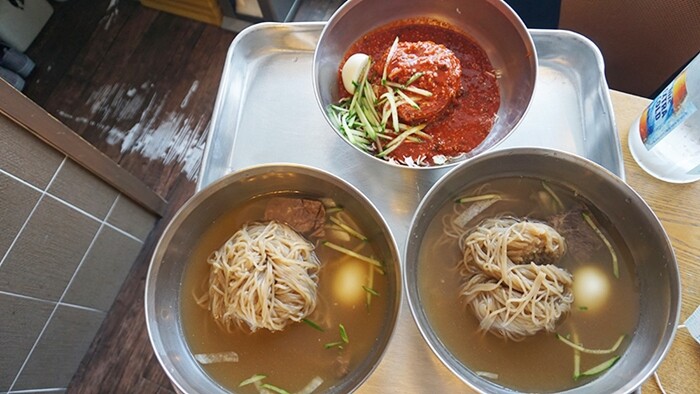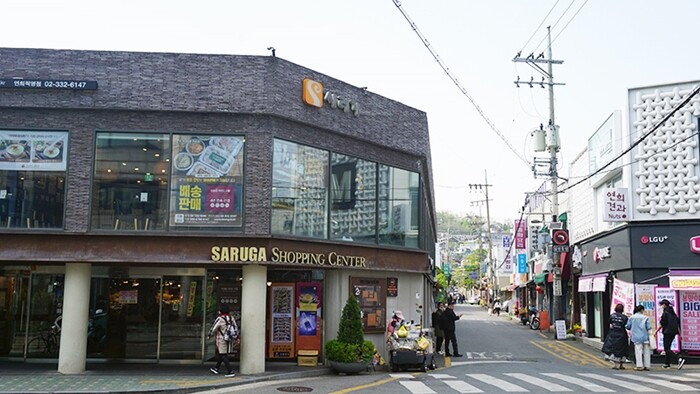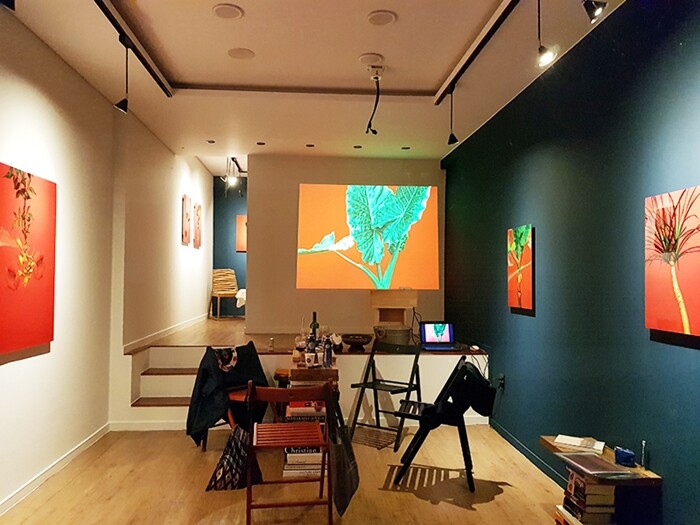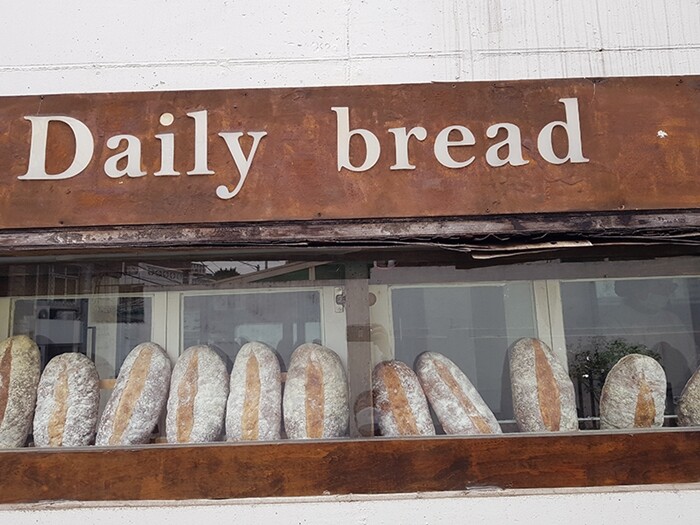hankyoreh
Links to other country sites 다른 나라 사이트 링크
[Seoul travels] Yeonhui and the analog lifestyle

There are a number of addictive things in the world. Here are just a few: spicy food, forbidden love, computer games where you’re trapped in a labyrinth, the ladder of success, TV shows that keep you glued to your seat. . .and naengmyeon (cold noodles).
One sunny day, I got an invitation to grab some naengmyeon from Kang Seong-gon, a newscaster at KBS. Kang, who hosts a well-known classical music program, has long been a regular at Pyeongtaekgoyeosajip Naengmyeon, in Seoul’s Yeonhui neighborhood.
Kang and I are joined by Lee Bong-gi, president of the South Korean branch of German company Faber-Castell. This multinational firm makes pencils and other writing instruments that remain successful in the digital era.
While the three of us — people who “used to look young,” to borrow Kang’s phrasing — enjoy our bowls of naengmyeon at a restaurant that’s been run by the same family for three generations now, we talk about craftsmanship, traditional music, and an analog lifestyle. Those three things have something in common: the passage of time only increases their appeal. And in a sense, the same can be said of Yeonhui itself.
“For the craftsperson, tools such as a pencil or a fountain pen seem to have a psychological aspect that goes beyond their mere functional purpose. The craftsperson probably regards them as dear friends in the creative process. When craftspeople choose the inconvenience of analog over the convenience of digital, aren’t they telling us that there’s something special about those tools?” Lee Bong-gi says, praising independent taste, and a life oriented on value, rather than price.
After our meal, I set out on my own to explore the neighborhood. Yeonhui is a curious place. There isn’t a major subway station in the area, it’s not easy to find a parking spot, and there aren’t any department stores or major franchise stores to be seen.

Even so, once you’ve settled down in Yeonhui, it isn’t easy to leave. Residents here seem to take a different sort of pride in the neighborhood than those in the ritzy Tower Palace in Daechi or other prestigious areas of Seoul such as Cheongdam, Seongbuk and Hannam. So what exactly is Yeonhui’s hidden appeal?
Given Yeonhui’s geographical proximity to Yonsei University, a unique culture has taken shape here, focused on university professors and staff and non-Koreans. While the area has recently come under the cultural sway of Hongdae, the mood in Yeonhui is quite different from adjacent Yeonnam.
Yeonhui has developed a mature culture of its own; there’s a neighborhood art fair and a festival called “Walking in Yeonhui.”
To the east of Yeonhui-ro Street, which runs through the neighborhood, are the Seoul Overseas Chinese High School and the Seoul Foreign School. But the area I plan to walk through is on the opposite side, on the west. That’s the location of Yeonhui “Taste Street” and Yeonhui-ro 11-ga-gil Street.

Shutterbugs head for Yeonhui-ro 11-ga-gil Street, the location of the larger studios and cultural centers, such as Yeonhui Grand Park, run by Urbanplay. The popular restaurants on Yeonhui Taste Street are near here, as is Saruga Shopping Center, a local landmark.
For some reason the word “Saruga” (which literally means “go to buy” in Korean) reminds me of “village.” That word is part of some of New York’s most distinctive artistic and cultural neighborhoods, such as West Village, the setting of “Sex and the City,” and Greenwich Village, a haunt of artists and writers. Although “village” connotes the backwardness of the countryside, it may also be a key term for our age.
My goal today is Yeonhui-ro 11-gil, an alley that runs perpendicular to the similarly named Yeonhui-ro 11-ga-gil. Heading north from Saruga Shopping Center, I’m pleased to see shops with down-to-earth names like Yeonnam Hardware and Electric Supplies, Jeongeum Electronics and Daegu Tteok (Rice Cake) Shop.
The alley consists of a peculiar blend of residential units and distinctive shops, including a leather workshop, a photo studio, a butcher’s shop, a florist, a flour mill and a sesame oil shop. Three that stand out are Geumokdang, which has achieved success by producing fancy versions of adzuki bean dishes including yanggaeng (red bean jelly); a small ice cream parlor that always has people lined up outside; and, across the street, a New York-style bagel shop called Everything Bagel.
I keep going north along Yeonhui-ro 11-gil until I reach a five-way intersection with a supermarket in front of me. To the left is Yeonhui Photo Studio and Seoyeon Middle School, while straight ahead is a cozy but chic art gallery called L153. It’s about 260 meters from Saruga Shopping Center, taking less than five minutes even for a slow walker.

After hearing that some photography is on display at the gallery, I get in touch with the owner — a complete stranger — and tell her I’d like to drop by. I’m determined not to miss such a good opportunity in the COVID-19 era.
I’m struck by the bright red of the photographs, which contrasts with the simple layout of the gallery. Lee Sang-jeong, the gallery owner, used to be the editor of “Madame Figaro,” a sophisticated women’s magazine. She created a stir on social media because of a trip she went on with her daughter — the two of them spent nearly a year exploring the backstreets of cities around the world.
“After leaving the magazine about eight years ago, I was looking for work that I would enjoy when a writer recommended I set up shop here. I was intrigued to hear that the gallery wouldn’t make me rich, but wouldn’t bankrupt me either,” Lee says with a chuckle.
Lee teams up with other ateliers in the backstreets of Yeonhui to organize a unique cultural event called “Yeonhui research lifestyle.” That’s hardly a surprise, given the pioneering role she has played in “art collaboration,” forging connections between art and designer brands.
Just as our conversation is getting interesting, several more visitors arrive, and Lee throws an impromptu wine party. The word “party” may sound a little grandiose for our simple spread — a single bottle of wine from the gallery, some cheese picked up from Saruga Shopping Center, and a baguette, still hot from the oven, from a delicious bakery in the area called Paul and Paulina.
But as I savor the aroma of the bread, the colors of the artwork, and the tales from people’s lives, tales that are every bit as diverse and powerful as those colors, I could hardly ask for more.
Hidden away on the other side of the building with the art gallery is a natural wine store called Vinoteca #202 with a gorgeous terrace. After picking up a bottle of wine, I return to the gallery and see locals who are passing by waving to me from outside the window.
The value of alleyways and back streetsIt’s obvious that this little gallery functions as a fantastic channel of communication in this backstreet, which is itself becoming a platform of culture. This strikes me as exactly the kind of charm that people have in mind when they talk about Yeonhui.
One of the guests at the party — Kim Jin-ho, a reporter for the Kyunghyang Shinmun — invites me to a dumpling restaurant in the area, where he shares some of the neighborhood’s history with me.
Lee Jun-mo, president of the Korean branch of Concern Worldwide, wrote the following account on Facebook: “The backstreets are gradually disappearing. But the stories of those backstreets are connected in unpredictable ways to people and neighborhoods, just as the twisting paths of our lives intersect.”
As a freelancer, I don’t belong to any particular organization. In the evening, I pull out my notebook and jot down the word “solidarity,” a word that has long gathered dust in the storehouse of my memory. Perhaps I see it as a synonym for “happiness.”
By Son Kwan-seung, travel writer
Edited by Seoul&
Please direct comments or questions to [english@hani.co.kr]
Editorial・opinion
![[Column] Has Korea, too, crossed the Rubicon on China? [Column] Has Korea, too, crossed the Rubicon on China?](https://flexible.img.hani.co.kr/flexible/normal/500/300/imgdb/original/2024/0419/9317135153409185.jpg) [Column] Has Korea, too, crossed the Rubicon on China?
[Column] Has Korea, too, crossed the Rubicon on China?![[Correspondent’s column] In Japan’s alliance with US, echoes of its past alliances with UK [Correspondent’s column] In Japan’s alliance with US, echoes of its past alliances with UK](https://flexible.img.hani.co.kr/flexible/normal/500/300/imgdb/original/2024/0419/2317135166563519.jpg) [Correspondent’s column] In Japan’s alliance with US, echoes of its past alliances with UK
[Correspondent’s column] In Japan’s alliance with US, echoes of its past alliances with UK- [Editorial] Does Yoon think the Korean public is wrong?
- [Editorial] As it bolsters its alliance with US, Japan must be accountable for past
- [Guest essay] Amending the Constitution is Yoon’s key to leaving office in public’s good graces
- [Editorial] 10 years on, lessons of Sewol tragedy must never be forgotten
- [Column] A death blow to Korea’s prosecutor politics
- [Correspondent’s column] The US and the end of Japanese pacifism
- [Guest essay] How Korea turned its trainee doctors into monsters
- [Guest essay] As someone who helped forge Seoul-Moscow ties, their status today troubles me
Most viewed articles
- 1[Column] The clock is ticking for Korea’s first lady
- 2Hong Se-hwa, voice for tolerance whose memoir of exile touched a chord, dies at 76
- 3After 2 months of delayed, denied medical care, Koreans worry worst may be yet to come
- 4[Column] Has Korea, too, crossed the Rubicon on China?
- 5Samsung barricades office as unionized workers strike for better conditions
- 6US overtakes China as Korea’s top export market, prompting trade sanction jitters
- 7All eyes on Xiaomi after it pulls off EV that Apple couldn’t
- 8[Guest essay] How Korea turned its trainee doctors into monsters
- 9[Editorial] As it bolsters its alliance with US, Japan must be accountable for past
- 10[Correspondent’s column] In Japan’s alliance with US, echoes of its past alliances with UK